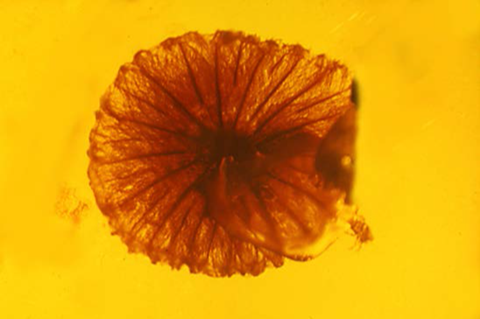New research published in Nature Ecology & Evolution sheds light on the timelines and pathways of evolution of fungi, finding evidence of their influence on ancient terrestrial ecosystems.

The study, led by researchers from the Okinawa Institute of Science and Technology (OIST) and collaborators, indicates the diversification of fungi hundreds of millions of years before the emergence of land plants.
READ MORE: Scientists strive to place tens of thousands of previously unknown fungi in the evolution tree
READ MORE: Researchers discover evolutionary “tipping point” in fungi
Professor Gergely J. Szöllősi, author on this study and head of the Model-Based Evolutionary Genomics Unit at OIST explains the foundations of this research. “Complex multicellular life — organisms made of many cooperating cells with specialized jobs — evolved independently in five major groups: animals, land plants, fungi, red algae, and brown algae.
”On a planet once dominated by single-celled organisms, a revolutionary change occurred not once, but at least five separate times: the evolution of complex multicellular life. Understanding when these groups emerged is fundamental to piecing together the history of life on Earth.”
Emergence here was not simply a matter of cells clumping together; it was the dawn of organisms, where cells took on specialized jobs and were organized into distinct tissues and organs, much like in our own bodies. This evolutionary leap required sophisticated new tools, including highly developed mechanisms for cells to adhere to one another and intricate systems for them to communicate across the organism, and arose independently in each of the five major groups.
The difficulties of dating evolutionary divergence
For most of these groups, the fossil record acts as a geological calendar, providing anchor points in deep time. For example, red algae show up possibly as early as about 1.6 billion years ago (in candidate seaweed-like fossils from India); animals appear by around 600 million years ago (Ediacaran fossils such as the quilted pancake like Dickinsonia); land plants take root roughly 470 million years ago (tiny fossil spores); and brown algae (kelp-like forms) diversified tens to hundreds of millions of years later still. Based on this evidence, a chronological picture of life’s complexity emerges.
There is, however, a notable exception to this fossil-based timeline: fungi. The fungal kingdom has long been an enigma for paleontologists. Their typically soft, filamentous bodies mean they rarely fossilize well. Furthermore, unlike animals or plants, which appear to have a single origin of complex multicellularity, fungi evolved this trait multiple times from diverse unicellular ancestors, making it difficult to pinpoint a single origin event in the sparse fossil record.
Reading the genetic clock
To overcome the gaps in the fungal fossil record, scientists use a “molecular clock.” The concept is that genetic mutations accumulate in an organism’s DNA at a relatively steady rate over generations, like the ticking of a clock. By comparing the number of genetic differences between two species, researchers can estimate how long ago they diverged from a common ancestor.
However, a molecular clock is uncalibrated; it can reveal relative time but not absolute years. To set the clock, scientists need to calibrate it with “anchor points” from the fossil record. Given the scarcity of fungal fossils, this has always been a major challenge. The OIST-led team addressed this by incorporating a novel source of information: rare gene “swaps” between different fungal lineages, a process known as horizontal gene transfer (HGT).
Temporal clues
Prof. Szöllősi explains this concept. “While genes are normally passed down “vertically” from parent to child, HGT is like a gene jumping “sideways” from one species to another. These events provide powerful temporal clues,” he says. “If a gene from lineage A is found to have jumped into lineage B, it establishes a clear rule: the ancestors of lineage A must be older than the descendants of lineage B.”
By identifying 17 such transfers, the team established a series of “older than/younger than” relationships that, alongside fossil records, helped to tighten and constrain the fungal timeline.
A new history for an ancient kingdom
The analysis suggests a common ancestor of living fungi dating to roughly 1.4–0.9 billion years ago—well before land plants. That timing supports a long prelude of fungi–algae interactions that helped set the stage for life on land.
Co-first author on this study, Dr. Lénárd L. Szánthó, emphasizes the importance of these findings. “Fungi run ecosystems—recycling nutrients, partnering with other organisms, and sometimes causing disease. Pinning down their timeline shows fungi were diversifying long before plants, consistent with early partnerships with algae that likely helped pave the way for terrestrial ecosystems.”
This revised timeline fundamentally reframes the story of life’s colonization of land. It suggests that for hundreds of millions of years before the first true plants took root, fungi were already present, likely interacting with algae in microbial communities. This long, preparatory phase may have been essential for making Earth’s continents habitable.
”By breaking down rock and cycling nutrients, these ancient fungi could have been the first true ecosystem engineers, creating the first primitive soils and fundamentally altering the terrestrial environment. In this new view, plants did not colonize a barren wasteland, but rather a world that had been prepared for them over eons by the ancient and persistent activity of the fungal kingdom.







No comments yet